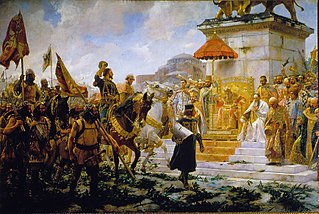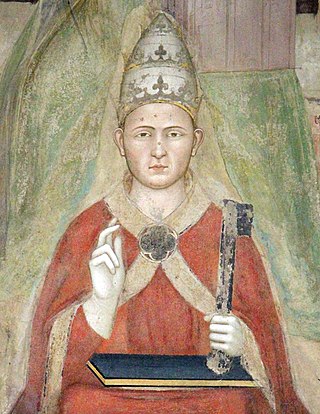The 1300s was a decade of the Julian Calendar that began on 1 January 1300 and ended on 31 December 1309.

The year 1300 (MCCC) was a leap year starting on Friday in the Julian calendar, the 1300th year of the Common Era (CE) and Anno Domini (AD) designations, the 300th year of the 2nd millennium, the 100th and last year of the 13th century, and the 1st year of the 1300s. The year 1300 was not a leap year in the Proleptic Gregorian calendar.

Year 1277 (MCCLXXVII) was a common year starting on Friday of the Julian calendar.
The 1280s is the decade starting January 1, 1280 and ending December 31, 1289.
The 1290s was a decade of the Julian Calendar which began on January 1, 1290, and ended on December 31, 1299.

Year 1303 (MCCCIII) was a common year starting on Tuesday of the Julian calendar.

Year 1304 (MCCCIV) was a leap year starting on Wednesday of the Julian calendar.

Year 1305 (MCCCV) was a common year starting on Friday of the Julian calendar.

Year 1316 (MCCCXVI) was a leap year starting on Thursday of the Julian calendar.

Year 1298 (MCCXCVIII) was a common year starting on Wednesday of the Julian calendar.

Year 1290 (MCCXC) was a common year starting on Sunday of the Julian calendar.
Mulay, Mûlay, Bulay was a general under the Mongol Ilkhanate ruler Ghazan at the end of the 13th century. Mulay was part of the 1299–1300 Mongol offensive in Syria and Palestine, and remained with a small force to occupy the land after the departure of Ghazan. He also participated in the last Mongol offensive in the Levant in 1303. His name has caused confusion for some historians, because of its similarity with that of the contemporary Grand Master of the Knights Templar, Jacques de Molay.
Hizabruddin, better known by his title Zafar Khan, was a general of the Delhi Sultanate ruler Alauddin Khalji. He held charge of Multan, Samana, and Sivistan, Sindh at various times during Alauddin's reign.

The Battle of Marj al-Saffar, also known as the Battle of Shaqhab, took place on April 20 through April 22, 1303 between the Mamluks and the Mongols and their Armenian allies near Kiswe, Syria, just south of Damascus. The battle has been influential in both Islamic history and contemporary time because of the controversial jihad against other Muslims and Ramadan related fatwas issued by Ibn Taymiyyah, who himself joined the battle. The battle, a disastrous defeat for the Mongols, put an end to Mongol invasions of the Levant.
The Mongol Empire launched numerous invasions into the Indian subcontinent from 1221 to 1327, with many of the later raids made by the Qaraunas of Mongol origin. The Mongols occupied parts of the subcontinent for decades. As the Mongols progressed into the Indian hinterland and reached the outskirts of Delhi, the Delhi Sultanate of India led a campaign against them in which the Mongol army suffered serious defeats.
Qutlugh Khwaja was a son of Duwa, the Mongol khan of Chagatai Khanate, a division of the Mongol Empire. He became a chief of the Qara'unas in Afghanistan after Abdullah was recalled by the Khan to Central Asia in around 1298–1299. It seems that later Ilkhans allowed him to settle with his Qaranaus in Afghanistan, though they were struggling with each other.

Alauddin Khalji, born Ali Gurshasp, was a ruler from the Khalji dynasty that ruled the Delhi Sultanate in the Indian subcontinent. Alauddin instituted a number of significant administrative changes in India, related to revenues, price controls, and society. He also successfully fended off several Mongol invasions of India.
Almas Beg, better known by his title Ulugh Khan, was a brother and a general of the Delhi Sultanate ruler Alauddin Khalji. He held the iqta' of Bayana in present-day India.
The Battle of Kili was fought in 1299 between the Mongols of the Chagatai Khanate and the Delhi Sultanate. The Mongols, led by Qutlugh Khwaja, invaded India, intending to conquer Delhi. When they encamped at Kili near Delhi, the Delhi Sultan Alauddin Khalji led an army to check their advance.
In 1298–99, a Mongol army invaded the Sindh region of the Delhi Sultanate, and occupied the fort of Sivistan in present-day Pakistan. The Delhi Sultan Alauddin Khalji dispatched his general Zafar Khan to evict the Mongols. Zafar Khan recaptured the fort, and imprisoned the Mongol leader Saldi and his companions.











